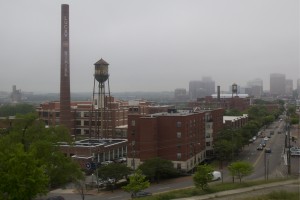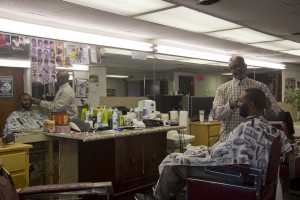Everyone I talk to drops in a new historical fact about Church Hill. This time, it’s about a tree. “It was there before Lincoln,” says Lynn Weiss, William and Mary Professor. She sits with her dog in the rain, longingly staring past her neighbor’s house and out at the Richmond skyline. Church Hill is full of hidden wonders, and laden with paradox. The block of houses I am walking towards is inhabited by a string of white professionals. She is one of a number of professors who has made Church Hill her home in the past few years. The commute from Williamsburg is worth it to find a neighborhood with the character Church Hill possesses. These houses are painted purple and blue, articulately detailed and prized.
Walk two blocks north, and the houses’ windows are boarded up, a mixture of abandoned and neglected. Neighbors glare when I pull out my camera. They know I don’t belong.
Everywhere I go, I am confronted with these contrasts. Outside East District Family Resource center, Albert Walker points across the street. “Patrick Henry’s speech. ‘Give me liberty or give me death’, that was right over there in St. John’s Church,” he says. The church and road are generic, lacking any obvious markers of this historical event. I never would have known. Church Hill is rife with history and contradictions.
Oakwood Cemetery spans a large portion of the neighborhood to the north. I walk in through the left gate of this sprawling cemetery, and am immediately confused. Although Oakwood Cemetery is located in a primarily black community, the gravestones represent a different reality. A series of Jewish names are engraved on the stones, indicating this bizarre placement of the Hebrew cemetery within Oakwood’s larger grasp. Upon some of the headstones lie a small stone, just larger than a pebble. Some are painted blue and white in the shape of the Star of David. These marks are for remembrance, a symbol that the dead are not forgotten. In an unusual juxtaposition, these graves are planted between those of African Americans and of Confederate soldiers. Oakwood Cemetery might just be the most diverse community in Richmond.
To my right lie the graves of these Confederates, recently honored with a line of miniature Confederate flags which surround their section. They, too, are not forgotten, even if these dead are generations past. The African American graves compose the rest of the cemetery. The community can’t help but be aware of the Confederates looming at these northern gates.
Just across the street from the cemetery lies Chris Pleasant’s barbershop, Kozy Hair Studio. Mr. Pleasant is talkative and optimistic, filled with ideas for the city’s future. He is well aware of the economic disparities of Church Hill. “The city is changing every hour of every day. Somebody is always making a decision and leaving somebody out. My culture, my people—are getting erased,” he says. After an hour of banter, which inevitably falls back into discussions of race relations and economic disparity, I say goodbye. I have never been as aware of my own race as I have been in Church Hill. Race comes back to every argument, and this generation of residents is still justifiably angry. The city’s choices over the past century have put African American communities far behind.
Church Hill’s history is hidden in the cracks. With the recent gentrification which encroaches on the neighborhood, its future is up for grabs. As more white professionals move in, the neighborhood loses a bit of its color. With four housing projects in the East End, and rising house prices overall, it is at a turning point. Through its history we see its future—no matter the current climate, Church Hill can fall back on its historic roots for hope.




